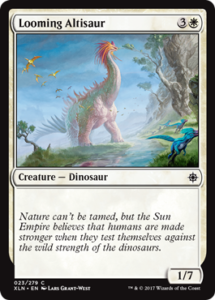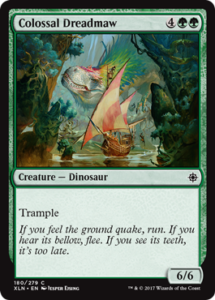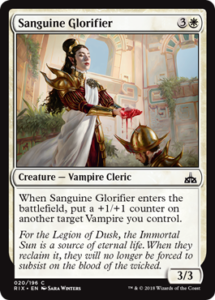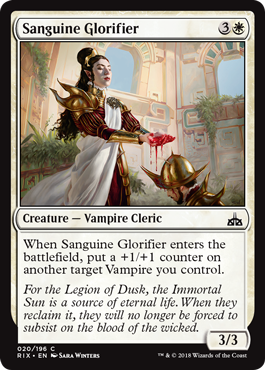Magic: The Gathering (MTG) is a game that is 25 years old, and it shows no signs of stopping. It’s still a prime feature at any game or hobby store you enter, and you’ll find that the stores are also crowded with people playing the game. Young people–teens and tweens–alongside older players whose spouses no doubt wish they’d find a less expensive hobby.
MTG has succeeded so long because of its ability to innovate. The game regularly reinvents itself with new sets, each of which is based in a “plane.” Together, these planes make a multiverse that is incredibly diverse. Each world is an intricately created fantasy. But these fantasies are all grounded and themed against different parts of our own world. There have been planes based on Medieval Japan, ancient Egypt, and Renaissance Italy. Because each of these worlds strips the flavor of these times and places, casting aside the actual historical peoples, places, and events, there are real questions of cultural appropriation here. Is MTG exploiting in a cheap ploy for novelty? Is it making each culture into a deck du jour, a shiny trinket to lure players into opening their wallets yet again?
This issue became especially important when they announced Ixalan, a Mesoamerican-themed world of dinosaurs, explorers, conquistadores, pirates, and natives whose style evoked the Mayans and Aztecs. Was MTG cheapening one of the world’s most horrific historical massacres into a sideshow? To some extent, the answer has to be “yes.” It is just a trick to get us to spend more money. They are exploiting the bloody, horrific events partly because they needed a new theme. But the answer is also, surprisingly, that the Ixalan cards are an impressively constructed critique of history. They create space for multiple indigenous cultures. They give these cultures power and agency. Along the way, they make a harsh critique of colonial powers by inverting tropes used to demonize indigenous peoples. And it’s also really fun to play.
I’m a relative neophyte to MTG. I started collecting cards a few years ago, but only really got into it last summer. Ixalan is a truly exciting set that engaged my imagination and made me want to play–and collect cards–as never before.I think it’s a plane that deserves a deep exploration of the cultural work in helping us understand and frame the historical conquest of the Americas.
No “Lost World”
 Initially, the most compelling aspect of Ixalan for me was the dinosaurs. It’s also the most problematic. Deciding to put dinosaurs in the world that is Mesoamerican themed comes with heavy cultural baggage.
Initially, the most compelling aspect of Ixalan for me was the dinosaurs. It’s also the most problematic. Deciding to put dinosaurs in the world that is Mesoamerican themed comes with heavy cultural baggage.
As Gar Atkins notes in “Ixalan through Indigenous Eyes,” there is a long history of associating Central and South America with “The Lost World.” The Lost World is a region that has been so isolated from the rest of the world that it has somehow remained primitive. While the rest of the world was evolving and changing, this region was stuck in its primitive state. And that includes, notably, its people. They are primitive people. Not just technologically: they are frequently less evolved than our (European) visitors.
This notion of asynchronous space, a conception that some parts of the world are actually chronologically behind others, was used to justify all manner of atrocities. Frequently, The Lost World was located in South America, as in Sir Arthur Conan Doyle’s namesake novel. It could be found anywhere–the center of the earth, the South Pole, a valley in the desert Southwest–but it was often linked to areas of colonial exploitation. Joseph Conrad alludes to it in “Heart of Darkness,” creating the image of interior Africa that is not just savage, but primitive as well.
However, Ixalan manages to sidestep this issue nicely. It’s got a little bit of an out because we’re not actually talking about Mesoamerica. But in order to truly create a plane that doesn’t just profit off this trope, it has to convince us that it is another place, and that we’re not just looking at a representation of a Lost World. They do that by creating dinosaurs that largely don’t fit in our biohistorical past.
There are no tyrannosaurs in Ixalan. There is a collossal dreadmaw, which has a passing resemblance, but it is a different creature entirely. Ixalan also judiciously uses feathers to give us dinosaurs that don’t look like they belong in our past. Sure, we know that many dinosaurs were feathered, but Hollywood stubbornly resists giving them feathers to preserve the memory of dinosaurs from our childhood, those that are in a continuous line from the 19th century and helped inspire the concept of a Lost World. The use of dinosaur armor, including a version of powered assault armor, also helps extract these dinosaurs from our past and places them not in a Lost World, but a parallel world, somewhat like Dougal Dixon’s The New Dinosaurs. These aren’t ancient creatures stuck in the past: they are living, vibrant creatures, shaped by evolution and part of a contemporary ecosystem.
A Conquest of Blood
After the dinosaurs, the most controversial aspect of Ixalan is its portrayal of the conquistadores as vampires. Atkins is upset with this because
Sometimes making actual monsters out of the perpetrators of a very human horror distances ourselves from the truth of the situation. It’s a lot easier to think of these people as unrepentant monsters than actual humans who were capable of terrible things. It’s easy to think that you would never be complicit in these sort of acts, but turn around and call the Water Protectors you see on TV thugs and criminals.
He has a point. It is important to remember that the actual conquistadores were human. That humans were capable of the systematic rape and murder that sought to destroy Indigenous Americans (and almost succeeded). It’s important to remember this, because it’s a reminder that we are all capable of inestimable evil, under the right circumstances. We need to be constantly aware of the ramifications of our thoughts, words, and actions, both as individuals and in the aggregate.
Other people critique the choice from the angle that it’s “unsubtle.”
I think both of these critiques are valid, but I feel the designers sidestepped them. First, the critique about shifting blame onto monsters. Vampires aren’t that far off from humans, especially the vampires used in this set. Sometimes, they have a pallor that is inhuman, but can also serve as a subtle critique of the fetishization of whiteness as goodness. They have pointy ears. And fangs. But otherwise, they look human.
Vampires have a long history in MTG, and this is not the first time they’ve represented vices that are all too human. For example, the Shadows over Innistrad card Indulgent Aristocrat shows an effete man taking a goblet of blood from a tower of goblets overflowing with blood. The flavor text says, “If you’re not surrounded by decadence, my question to you is–why not?” These creatures may not be us in name, but they are recognizably human. And cards like Queen’s Commission, Anointed Deacon, and Bishop’s Soldier, link us to the historical political and religious authorities that put their stamp of approval on the brutal conquest.
Ixalan also makes the smart choice of making many of the conquistadores use white mana, where previous vampires typically used black. The conquistadores saw themselves as lightbringers. As did other European colonists in America, Asia, and, of course, the “dark continent” of Africa. Adding to the critique of whiteness, the irony of light-loving vampires is in its own way delicious.
But perhaps the best thing about making the conquistadores vampires is the way it inverts tropes that have been used repeatedly to denigrate Indigenous Mesoamericans. Colonial narratives have made ritual blood sacrifice so synonymous with Aztec and Mayan culture that for many people it’s the first thing that comes to our minds when we imagine these societies. (This is made painfully clear in a scene from the comedy GLOW. When heroine Ruth visits the Mayan Theater as a potential venue, almost the first words out of her mouth are a joke about blood sacrifice.) But turning the conquistadores into vampires inverts this trope beautifully.
 My favorite card for this is Sanguine Glorifier. It portrays a priestess holding out hands brimming with blood that drips on the helmet of a kneeling conquistador. The image immediately invoked in me the memory of that image we have all seen in textbooks of the Aztec priest standing atop a pyramid, holding aloft the heart of a sacrifice. It achieves more than just turning the image of human sacrifice back on the conquistadores. It reminds us that for as much as Europeans demonized cannibalism, it’s central to their faith. Communion is (for Catholics) eating the literal flesh and drinking the literal blood of another human being. And, for as much as they sought to eradicate the heathen rituals, they were just replacing it with their own abominable ritual.
My favorite card for this is Sanguine Glorifier. It portrays a priestess holding out hands brimming with blood that drips on the helmet of a kneeling conquistador. The image immediately invoked in me the memory of that image we have all seen in textbooks of the Aztec priest standing atop a pyramid, holding aloft the heart of a sacrifice. It achieves more than just turning the image of human sacrifice back on the conquistadores. It reminds us that for as much as Europeans demonized cannibalism, it’s central to their faith. Communion is (for Catholics) eating the literal flesh and drinking the literal blood of another human being. And, for as much as they sought to eradicate the heathen rituals, they were just replacing it with their own abominable ritual.
Disposable Planes, Disposable People
We have to acknowledge at the end that, for as well-done as Ixalan is, it’s still just cultural appropriation for transitory profit. Ixalan debuted in September, got a supplemental release in January, and in another month it will be replaced with a new plane. Huatli, dinosaur knight and warrior poet, may be an inspiring character, but she’s still just a disposable pawn in Wizards of the Coast’s real game: trying to lure more people into spending more money on MTG cards.

